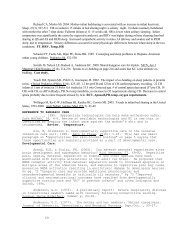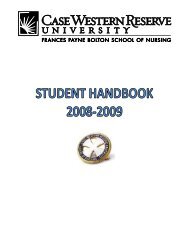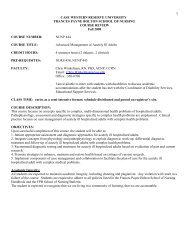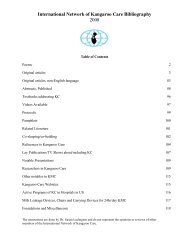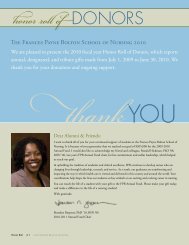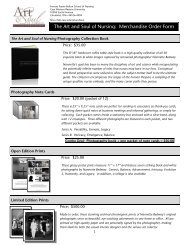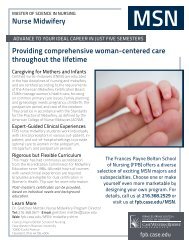Shared Governance and Empowerment in Registered Nurses ...
Shared Governance and Empowerment in Registered Nurses ...
Shared Governance and Empowerment in Registered Nurses ...
You also want an ePaper? Increase the reach of your titles
YUMPU automatically turns print PDFs into web optimized ePapers that Google loves.
LWW/NAQ NAQ200100 May 28, 2011 3:7<br />
Nurs Adm<strong>in</strong> Q<br />
Vol. 35, No. 3, pp. 212–218<br />
Copyright c○ 2011 Wolters Kluwer Health | Lipp<strong>in</strong>cott Williams & Wilk<strong>in</strong>s<br />
<strong>Shared</strong> <strong>Governance</strong> <strong>and</strong><br />
<strong>Empowerment</strong> <strong>in</strong> <strong>Registered</strong><br />
<strong>Nurses</strong> Work<strong>in</strong>g <strong>in</strong> a Hospital<br />
Sett<strong>in</strong>g<br />
Agnes M. Barden, DNP, RN;<br />
Mary T. Qu<strong>in</strong>n Griff<strong>in</strong>, PhD, RN;<br />
Moreen Donahue, DNP, RN, NEA-BC;<br />
Joyce J. Fitzpatrick, PhD, MBA, RN, FAAN<br />
<strong>Empowerment</strong> of registered nurses through professional practice models <strong>in</strong>clusive of shared<br />
governance has been proposed as essential to improve quality patient care, conta<strong>in</strong> costs, <strong>and</strong> reta<strong>in</strong><br />
nurs<strong>in</strong>g staff. The purpose of this study was to determ<strong>in</strong>e the relationship between perceptions<br />
of governance <strong>and</strong> empowerment among nurses work<strong>in</strong>g <strong>in</strong> acute care hospital units <strong>in</strong> which a<br />
shared governance model had been <strong>in</strong> place for 6 to 12 months. The 158 nurses who participated<br />
perceived themselves to be moderately empowered <strong>and</strong> <strong>in</strong> an early implementation stage of<br />
shared governance. There was a statistically significant positive relationship between perceptions<br />
of shared governance <strong>and</strong> empowerment. Recommendations for professional practice <strong>and</strong> future<br />
research are <strong>in</strong>cluded. Key words: acute care sett<strong>in</strong>g, empowerment, shared governance<br />
EMPOWERMENT OF REGISTERED<br />
NURSES (RNs) through professional<br />
practice models <strong>in</strong>clusive of shared governance<br />
has been proposed to be essential to<br />
improve quality patient care, conta<strong>in</strong> costs,<br />
<strong>and</strong> reta<strong>in</strong> nurs<strong>in</strong>g staff. Economic constra<strong>in</strong>ts<br />
<strong>and</strong> the need for health care systems to cut<br />
costs have led to a series of measures that<br />
<strong>in</strong>fluence nurs<strong>in</strong>g, <strong>in</strong>clud<strong>in</strong>g earlier discharge<br />
of patients, downsiz<strong>in</strong>g of the professional<br />
workforce, changes <strong>in</strong> staff mixes, restruc-<br />
Author Affiliations: Nurs<strong>in</strong>g Education <strong>and</strong><br />
Research, Long Isl<strong>and</strong> Jewish Hospital, New Hyde<br />
Park, New York (Dr Barden); Frances Payne Bolton<br />
School of Nurs<strong>in</strong>g, Case Western Reserve University,<br />
Clevel<strong>and</strong>, Ohio (Drs Griff<strong>in</strong> <strong>and</strong> Fitzpatrick); <strong>and</strong><br />
Patient Care Services, Danbury Hospital, Danbury,<br />
Connecticut (Dr Donahue).<br />
Correspondence: Agnes M. Barden, DNP, RN, Nurs<strong>in</strong>g<br />
Education <strong>and</strong> Research, Long Isl<strong>and</strong> Jewish Hospital,<br />
270-05 76th Ave, New Hyde Park, NY 1104<br />
(abarden3@yahoo.com).<br />
DOI: 10.1097/NAQ.0b013e3181ff3845<br />
tur<strong>in</strong>g of services, <strong>and</strong> decreased support<br />
services for patient care. 1 In an economically<br />
constra<strong>in</strong>ed health care system, it is a challenge<br />
to develop <strong>and</strong> ma<strong>in</strong>ta<strong>in</strong> a professional<br />
practice model of nurs<strong>in</strong>g. A professional<br />
practice model of nurs<strong>in</strong>g has several goals,<br />
<strong>in</strong>clud<strong>in</strong>g the achievement of positive patient<br />
care outcomes, improved recruitment <strong>and</strong><br />
retention of nurses, <strong>and</strong> the provision of<br />
necessary support <strong>and</strong> resources. 1 <strong>Shared</strong><br />
governance, which gives staff nurses control<br />
over their professional practice, is an essential<br />
element of a professional practice nurs<strong>in</strong>g<br />
model, provid<strong>in</strong>g structure <strong>and</strong> context for<br />
health care delivery. 2-4<br />
The <strong>in</strong>creas<strong>in</strong>g shortage of professional<br />
nurses is a matter of grave concern. Many<br />
experienced nurses are approach<strong>in</strong>g retirement<br />
<strong>and</strong> fewer <strong>in</strong>dividuals are choos<strong>in</strong>g to<br />
enter the profession. 2,5,6 As a result of downsiz<strong>in</strong>g<br />
<strong>in</strong>itiatives <strong>in</strong> health care, nurses have<br />
heavier workloads <strong>and</strong> <strong>in</strong>creased responsibilities,<br />
lead<strong>in</strong>g to concerns about patient safety.<br />
212<br />
Copyright © 2011 Lipp<strong>in</strong>cott Williams & Wilk<strong>in</strong>s. Unauthorized reproduction of this article is prohibited.
LWW/NAQ NAQ200100 May 28, 2011 3:7<br />
<strong>Shared</strong> <strong>Governance</strong> <strong>and</strong> <strong>Empowerment</strong> <strong>in</strong> <strong>Registered</strong> <strong>Nurses</strong> 213<br />
Concentrated efforts are needed to improve<br />
the work<strong>in</strong>g conditions of nurses, reta<strong>in</strong><br />
nurses <strong>in</strong> the workplace, <strong>and</strong> encourage<br />
<strong>and</strong> develop new recruits to the nurs<strong>in</strong>g<br />
profession. 5,6<br />
The nurs<strong>in</strong>g shortage has revitalized the<br />
need for shared governance <strong>in</strong> nurs<strong>in</strong>g. 2 Dur<strong>in</strong>g<br />
the 1980s, when shared governance was<br />
first <strong>in</strong>troduced, participatory management <strong>in</strong><br />
which staff nurses were <strong>in</strong>volved <strong>in</strong> decisionmak<strong>in</strong>g<br />
processes led to <strong>in</strong>creased job satisfaction<br />
<strong>and</strong> improved patient outcomes. 6<br />
<strong>Shared</strong> governance is an <strong>in</strong>tegral component<br />
of professional practice nurs<strong>in</strong>g models<br />
<strong>in</strong> hospitals that have atta<strong>in</strong>ed the American<br />
Nurs<strong>in</strong>g Credential<strong>in</strong>g Center Magnet<br />
designation. Magnet-designated organizations<br />
serve as the gold st<strong>and</strong>ard of knowledge <strong>and</strong><br />
expertise for the delivery of nurs<strong>in</strong>g care<br />
globally. The American Nurs<strong>in</strong>g Credential<strong>in</strong>g<br />
Center Magnet model focuses on 5 components:<br />
transformational leadership; structural<br />
empowerment; exemplary professional nurs<strong>in</strong>g<br />
practice; new knowledge, <strong>in</strong>novations,<br />
<strong>and</strong> improvements; <strong>and</strong> empirical quality outcomes.<br />
In the designation process, each of<br />
these components is weighted to determ<strong>in</strong>e<br />
achievement of Magnet status. Sources of evidence<br />
are reviewed, <strong>and</strong> site visits are done<br />
by Magnet surveyors. 7 Research on Magnet<br />
hospitals has shown that nurses are attracted<br />
to hospital work environments that foster<br />
good <strong>in</strong>terdiscipl<strong>in</strong>ary relationships, promote<br />
autonomy, <strong>and</strong> support control over nurs<strong>in</strong>g<br />
practice. 5 <strong>Shared</strong> governance provides an opportunity<br />
for nurses to exercise control over<br />
their practice.<br />
Hospitals aim<strong>in</strong>g to achieve American Nurs<strong>in</strong>g<br />
Credential<strong>in</strong>g Center Magnet recognition<br />
status have begun to implement shared governance<br />
<strong>in</strong> their nurs<strong>in</strong>g practices. Several<br />
forces of Magnetism, <strong>in</strong>dicators for the Magnet<br />
program, reflect the values of shared<br />
governance <strong>and</strong> staff-based decision mak<strong>in</strong>g. 8<br />
National organizations, such as the American<br />
Hospital Association <strong>and</strong> the Institute of<br />
Medic<strong>in</strong>e, have recommended the creation<br />
of Magnet work environments as a strategy<br />
to assure excellent patient care delivery. 9-11<br />
Staff nurses work<strong>in</strong>g <strong>in</strong> Magnet hospitals have<br />
demonstrated empowerment <strong>and</strong> greater levels<br />
of job satisfaction than staff nurses work<strong>in</strong>g<br />
<strong>in</strong> a non-Magnet facilities. 12 <strong>Empowerment</strong>,<br />
participatory change management, <strong>and</strong><br />
shared leadership are key characteristics of<br />
Magnet hospitals. 13 The study hospital had begun<br />
its journey on the road to Magnet designation<br />
<strong>in</strong> 2007 <strong>and</strong> the development of a shared<br />
governance model was hoped to be <strong>in</strong>strumental<br />
<strong>in</strong> a positive cultural transformation.<br />
<strong>Nurses</strong> need to be empowered to make<br />
decisions about their practice. Decision mak<strong>in</strong>g<br />
that is staff driven is a strong <strong>in</strong>dicator<br />
of excellence. Excellence <strong>in</strong> nurs<strong>in</strong>g practice<br />
can only be achieved <strong>and</strong> susta<strong>in</strong>ed if nurses<br />
have <strong>in</strong>fluence that leads to satisfaction <strong>and</strong><br />
excellence. 8 <strong>Shared</strong> governance provides a<br />
vital communication <strong>and</strong> decision-mak<strong>in</strong>g <strong>in</strong>frastructure<br />
that is an essential element for a<br />
professional practice environment. 1 As health<br />
care systems embark on systems of shared<br />
governance, it is important to evaluate their<br />
effectiveness <strong>and</strong> their impact on empowerment<br />
for the hospital-based nurse. 14-16<br />
<strong>Shared</strong> governance has been an important<br />
management strategy for many years. Other<br />
discipl<strong>in</strong>es <strong>in</strong>clud<strong>in</strong>g bus<strong>in</strong>ess, education, politics,<br />
<strong>and</strong> religion have implemented <strong>and</strong> benefited<br />
from the utilization of shared governance<br />
models. 1,2 Health care organizations<br />
have mirrored the success of other <strong>in</strong>dustries<br />
by design<strong>in</strong>g decentralized, <strong>in</strong>terpersonal<br />
structures <strong>and</strong> relationships among staff <strong>and</strong><br />
adm<strong>in</strong>istrators 1,17-19<br />
The concept of shared governance came<br />
<strong>in</strong>to nurs<strong>in</strong>g practice <strong>in</strong> the 1980s through the<br />
work of Porter-O’Grady. It was seen as a strategy<br />
to enable nurses to exercise control over<br />
decisions that affected their practice. Porter-<br />
O’Grady emphasized that shared governance<br />
is a professional practice model based clearly<br />
<strong>in</strong> the pr<strong>in</strong>ciples of partnership, equity, accountability,<br />
<strong>and</strong> ownership at the unit level<br />
where the po<strong>in</strong>t of service occurs. 20<br />
In the 1980s, shared governance <strong>in</strong> nurs<strong>in</strong>g<br />
began to grow as a result of nurses’ dissatisfaction<br />
with<strong>in</strong> their respective hospitals. 1,18-21<br />
However, <strong>in</strong> the late 1990s, many elements of<br />
Copyright © 2011 Lipp<strong>in</strong>cott Williams & Wilk<strong>in</strong>s. Unauthorized reproduction of this article is prohibited.
LWW/NAQ NAQ200100 May 28, 2011 3:7<br />
214 NURSING ADMINISTRATION QUARTERLY/JULY–SEPTEMBER 2011<br />
shared governance were elim<strong>in</strong>ated. Although<br />
some hospitals ma<strong>in</strong>ta<strong>in</strong>ed their shared<br />
governance structure many hospitals disb<strong>and</strong>ed<br />
their councils <strong>and</strong> fewer hospitals began<br />
to <strong>in</strong>vest <strong>in</strong> the shared governance structure.<br />
The Journal of <strong>Shared</strong> <strong>Governance</strong>,<br />
which was created <strong>in</strong> the early 1980s when<br />
shared governance was popular, ceased publication<br />
<strong>in</strong> the late 1990s because of the lack<br />
of <strong>in</strong>terest <strong>in</strong> shared governance <strong>in</strong> nurs<strong>in</strong>g. 2<br />
Before 1998, consistent relationships had<br />
not been found between shared governance<br />
models <strong>and</strong> outcomes. 22 Furthermore, there<br />
was a lack of valid <strong>and</strong> reliable <strong>in</strong>struments<br />
to measure changes <strong>in</strong> governance, <strong>and</strong> no<br />
mechanism was available to connect changes<br />
to certa<strong>in</strong> outcomes. 22,23<br />
<strong>Shared</strong> governance <strong>in</strong> nurs<strong>in</strong>g has been<br />
<strong>in</strong> existence for more than 20 years. Much<br />
research on shared governance was done<br />
<strong>in</strong> the late 1980s <strong>and</strong> 1990s. Little research<br />
has been done on shared governance s<strong>in</strong>ce<br />
the late 1990s. Only one research study has<br />
been done exam<strong>in</strong><strong>in</strong>g shared governance <strong>and</strong><br />
empowerment <strong>in</strong> nurs<strong>in</strong>g. 23 In this study,<br />
the researcher exam<strong>in</strong>ed differences <strong>in</strong> the<br />
<strong>in</strong>dicators of professional governance, empowerment,<br />
<strong>and</strong> job satisfaction between<br />
nurses work<strong>in</strong>g <strong>in</strong> a shared governance sett<strong>in</strong>g<br />
<strong>and</strong> nurses work<strong>in</strong>g <strong>in</strong> a nonshared<br />
governance sett<strong>in</strong>g. <strong>Nurses</strong> <strong>in</strong> the shared governance<br />
sett<strong>in</strong>g had significantly higher scores<br />
<strong>in</strong> overall governance, empowerment, <strong>and</strong> job<br />
satisfaction than nurses <strong>in</strong> the non-shared governance<br />
sett<strong>in</strong>g. A moderate significant relationship<br />
was found between governance <strong>and</strong><br />
empowerment <strong>and</strong> governance <strong>and</strong> job satisfaction<br />
<strong>in</strong> both groups. 23 This is the only<br />
study on shared governance <strong>and</strong> empowerment.<br />
Further research is warranted to study<br />
this relationship.<br />
SUMMARY OF LITERATURE ON SHARED<br />
GOVERNANCE<br />
Hess’s Index of Professional Nurs<strong>in</strong>g <strong>Governance</strong><br />
(IPNG) has been utilized <strong>in</strong> health<br />
care organizations to measure governance for<br />
more than 10 years. 1 The literature does not<br />
<strong>in</strong>clude consistent f<strong>in</strong>d<strong>in</strong>gs that shared governance<br />
achieves desired outcomes. A number<br />
of researchers reported <strong>in</strong>significant or negative<br />
f<strong>in</strong>d<strong>in</strong>gs 24,25 <strong>and</strong> one positive f<strong>in</strong>d<strong>in</strong>g. 26<br />
Other researchers reported mixed results. 6,27<br />
Despite the prevalence of shared governance<br />
<strong>in</strong> the 1980s <strong>and</strong> the current resurgence,<br />
there has been little research on shared<br />
governance.<br />
Summary of literature on empowerment<br />
Several studies provided support for Kanter’s<br />
theory, show<strong>in</strong>g that Kanter’s theory<br />
could be used to assist nurs<strong>in</strong>g leaders <strong>in</strong> creat<strong>in</strong>g<br />
structures such as shared governance.<br />
These structures <strong>in</strong>crease accessibility of <strong>in</strong>formation<br />
<strong>and</strong> resources, re<strong>in</strong>force the importance<br />
of workforce empowerment, <strong>and</strong><br />
provide a satisfy<strong>in</strong>g work environment for<br />
nurses. Researchers also l<strong>in</strong>ked empowerment<br />
to Magnet characteristics, certification,<br />
<strong>and</strong> patient satisfaction.<br />
Summary of literature on shared<br />
governance <strong>and</strong> empowerment<br />
There was <strong>in</strong>consistency <strong>in</strong> the literature<br />
regard<strong>in</strong>g the outcomes of implementation<br />
of models of shared governance. Negative<br />
f<strong>in</strong>d<strong>in</strong>gs between the correlation of shared<br />
governance <strong>and</strong> autonomy <strong>in</strong> RNs work<strong>in</strong>g<br />
<strong>in</strong> shared governance structures were<br />
found primarily <strong>in</strong> the late 1990s <strong>and</strong> 2000.<br />
Positive f<strong>in</strong>d<strong>in</strong>gs were found <strong>in</strong> current literature.<br />
The relationship between Magnet<br />
designation <strong>and</strong> shared governance was supported.<br />
Magnet-designated hospitals participate<br />
<strong>in</strong> shared governance models <strong>and</strong> embrace<br />
the empowerment of their staff. Many<br />
studies on shared governance were focused<br />
on job satisfaction, retention of staff, <strong>and</strong> patient<br />
satisfaction. There has been limited research<br />
done on the relationship of the measurement<br />
of governance <strong>and</strong> empowerment<br />
<strong>in</strong> staff nurses. This study was designed to add<br />
to the knowledge of shared governance <strong>and</strong><br />
empowerment.<br />
The purpose of this descriptive correlational<br />
study was to determ<strong>in</strong>e the relationship<br />
between perceptions of governance <strong>and</strong><br />
Copyright © 2011 Lipp<strong>in</strong>cott Williams & Wilk<strong>in</strong>s. Unauthorized reproduction of this article is prohibited.
LWW/NAQ NAQ200100 May 28, 2011 3:7<br />
<strong>Shared</strong> <strong>Governance</strong> <strong>and</strong> <strong>Empowerment</strong> <strong>in</strong> <strong>Registered</strong> <strong>Nurses</strong> 215<br />
empowerment among nurses work<strong>in</strong>g <strong>in</strong> an<br />
acute hospital sett<strong>in</strong>g. Kanter’s structural theory<br />
of empowerment was the conceptual<br />
framework for the study conducted <strong>in</strong> a large<br />
tertiary care hospital located <strong>in</strong> Queens, New<br />
York. The purposive sample <strong>in</strong>cluded 348<br />
nurses work<strong>in</strong>g <strong>in</strong> the study site facility <strong>in</strong> 13<br />
units that had a shared governance model <strong>in</strong><br />
place for at least 6 months to 1 year. The study<br />
units <strong>in</strong>cluded medic<strong>in</strong>e, surgery, neurology,<br />
orthopedics, oncology, <strong>and</strong> cardiology. The<br />
total number of nurses that participated was<br />
158. The participants completed 2 surveys:<br />
the Index of Professional Nurs<strong>in</strong>g <strong>Governance</strong><br />
<strong>and</strong> the Conditions of Work Effectiveness II<br />
Questionnaire (CWEQ-II).<br />
Data were analyzed us<strong>in</strong>g Statistical Analysis<br />
Software (IBMSPSS, Armonk, New York)<br />
to evaluate the research question. Descriptive<br />
statistics were used to describe the sample.<br />
Frequency distributions were utilized to describe<br />
the percentage of RNs for each categorical<br />
background variable (gender, age, basic<br />
nurs<strong>in</strong>g educational preparation, highest<br />
educational preparation, employment status,<br />
years practic<strong>in</strong>g nurs<strong>in</strong>g, present position <strong>in</strong><br />
nurs<strong>in</strong>g, nurs<strong>in</strong>g unit, years worked <strong>in</strong> the <strong>in</strong>stitution,<br />
years <strong>in</strong> present position, certification<br />
status, <strong>and</strong> council member status). Measures<br />
of central tendency (mean, median, <strong>and</strong><br />
mode) <strong>and</strong> variability (range <strong>and</strong> st<strong>and</strong>ard deviation)<br />
were used to describe each cont<strong>in</strong>uous<br />
variable.<br />
To answer the research question, what<br />
is the relationship between perception of<br />
shared governance <strong>and</strong> empowerment among<br />
nurses who work <strong>in</strong> a professional governance<br />
structure <strong>in</strong> a hospital sett<strong>in</strong>g, Cronbach<br />
alpha was used to establish the reliability<br />
of the <strong>in</strong>struments <strong>in</strong> the study sample, <strong>and</strong><br />
Pearson product moment correlational analysis<br />
was used.<br />
Descriptive statistics revealed that nurses<br />
were <strong>in</strong> an early implementation phase of<br />
shared governance <strong>and</strong> the nurses perceived<br />
themselves to be moderately empowered.<br />
There was a significant relationship (r = 0.34,<br />
P < .0001) between perceptions of shared<br />
governance <strong>and</strong> empowerment. This <strong>in</strong>dicated<br />
that as shared governance progressed<br />
so did empowerment.<br />
The sample <strong>in</strong>cluded 158 RNs. The majority<br />
of the nurses was women, staff nurses,<br />
worked full-time, <strong>and</strong> were aged between 22<br />
<strong>and</strong> 65 years. The total score on the IPNG<br />
was 157.61, <strong>in</strong>dicative of traditional governance<br />
seen <strong>in</strong> early implementation of shared<br />
governance <strong>in</strong>novation. 28 The total score on<br />
the CWEQ-II was <strong>in</strong>dicative of moderate levels<br />
of empowerment. 29 A Pearson correlation<br />
coefficient on the sum of the IPNG<br />
<strong>and</strong> the CWEQ-II revealed a significant relationship<br />
among the variables. There was a<br />
moderate positive l<strong>in</strong>ear correlation between<br />
shared governance <strong>and</strong> empowerment. Additional<br />
analysis revealed no significance between<br />
the background variables of gender,<br />
age, educational level, employment status,<br />
years practic<strong>in</strong>g nurs<strong>in</strong>g, years <strong>in</strong> present position,<br />
years at <strong>in</strong>stitution, certification status,<br />
or council status <strong>and</strong> the CWEQ-II <strong>and</strong> the<br />
IPNG. As shared governance <strong>in</strong>creased so did<br />
empowerment.<br />
<strong>Nurses</strong> <strong>in</strong> this study perceived themselves<br />
to be moderately empowered. The average<br />
score of the CWEQ-II survey was 19.88. Accord<strong>in</strong>g<br />
to Lasch<strong>in</strong>ger, 30 a score between 14<br />
<strong>and</strong> 22 is <strong>in</strong>dicative of empowerment at a moderate<br />
level. The CWEQ-II mean score for this<br />
study exceeded all but one study reported<br />
by Lasch<strong>in</strong>ger on her Web site for hospital<br />
nurses. Conditions of Work Effectiveness<br />
II Questionnaire scores from previous studies<br />
ranged from 17.35 to 20.04. The implementation<br />
of the health system’s professional<br />
practice model for all discipl<strong>in</strong>es with<strong>in</strong> the<br />
organization may account for this relatively<br />
high score. In addition the implementation of<br />
the shared governance element of the professional<br />
practice model may have also contributed<br />
to this score.<br />
<strong>Empowerment</strong> subscale mean scores for<br />
this study exceeded or were <strong>in</strong> the upper<br />
range to previous studies reported by<br />
Lasch<strong>in</strong>ger on her Web site with the exception<br />
of Resources, which was <strong>in</strong> the lower<br />
range. 30 <strong>Nurses</strong> <strong>in</strong> this study rated access<br />
to opportunity as the highest empowerment<br />
Copyright © 2011 Lipp<strong>in</strong>cott Williams & Wilk<strong>in</strong>s. Unauthorized reproduction of this article is prohibited.
LWW/NAQ NAQ200100 May 28, 2011 3:7<br />
216 NURSING ADMINISTRATION QUARTERLY/JULY–SEPTEMBER 2011<br />
subscale (M = 4.13), followed by <strong>in</strong>formation<br />
(M = 3.34), support (M = 3.26), <strong>and</strong> resources<br />
(M = 2.83).<br />
Implications for nurs<strong>in</strong>g<br />
The study results demonstrate a positive relationship<br />
between a nurse’s perception of<br />
shared governance <strong>and</strong> empowerment. In an<br />
economically constra<strong>in</strong>ed health care system,<br />
it is challeng<strong>in</strong>g to ma<strong>in</strong>ta<strong>in</strong> a professional<br />
practice model of nurs<strong>in</strong>g where the goals<br />
<strong>in</strong>clude achievement of positive patient care<br />
outcomes, improved recruitment <strong>and</strong> retention,<br />
<strong>and</strong> provision of necessary support <strong>and</strong><br />
resources. 1 <strong>Shared</strong> governance is an essential<br />
element of a professional practice nurs<strong>in</strong>g<br />
model provid<strong>in</strong>g structure <strong>and</strong> context<br />
for health care delivery. 3 The total score on<br />
the IPNG was 157.61, <strong>in</strong>dicative of traditional<br />
governance seen <strong>in</strong> early implementation<br />
of shared governance <strong>in</strong>novation. 28 The<br />
total score on the CWEQ-II was <strong>in</strong>dicative of<br />
moderate levels of empowerment. 29 APearson<br />
correlation coefficient on the sum of the<br />
IPNG <strong>and</strong> the CWEQ-II revealed a significant<br />
relationship among the variables. There was a<br />
moderate positive l<strong>in</strong>ear correlation between<br />
shared governance <strong>and</strong> empowerment. Additional<br />
analysis revealed no significance between<br />
the background variables of gender,<br />
age, educational level, employment status,<br />
years practic<strong>in</strong>g nurs<strong>in</strong>g, years <strong>in</strong> present position,<br />
years at <strong>in</strong>stitution, certification status,<br />
or council status <strong>and</strong> the CWEQ-II <strong>and</strong> the<br />
IPNG. As shared governance <strong>in</strong>creased so did<br />
empowerment.<br />
<strong>Shared</strong> governance provides a vital communication<br />
<strong>and</strong> decision-mak<strong>in</strong>g <strong>in</strong>frastructure.<br />
The current nurs<strong>in</strong>g shortage has revitalized<br />
the need for shared governance <strong>in</strong> nurs<strong>in</strong>g<br />
by provid<strong>in</strong>g an environment where nurses<br />
are <strong>in</strong>volved <strong>in</strong> decision-mak<strong>in</strong>g processes.<br />
This can lead to improved patient outcomes<br />
<strong>and</strong> <strong>in</strong>creased job satisfaction. 6,12 <strong>Shared</strong> governance<br />
is a suggested strategy to improve<br />
job satisfaction for the younger generation<br />
of nurses. 31 American Nurs<strong>in</strong>g Credential<strong>in</strong>g<br />
Center Magnet hospitals support shared governance<br />
structures <strong>and</strong> Kanter’s theory of<br />
structural empowerment. This study results<br />
provides a basel<strong>in</strong>e for the hospital as it cont<strong>in</strong>ues<br />
on its Magnet journey. Nurse executives<br />
play a key role <strong>in</strong> the creation <strong>and</strong> sustenance<br />
of a professional practice environment<br />
that promotes a culture of cl<strong>in</strong>ical excellence,<br />
autonomy, collaborative decision mak<strong>in</strong>g, <strong>and</strong><br />
positive <strong>in</strong>terdiscipl<strong>in</strong>ary relationships.<br />
Suggestions for future research<br />
This study was an <strong>in</strong>itial evaluation of<br />
shared governance <strong>and</strong> empowerment of<br />
nurses <strong>in</strong> the study <strong>in</strong>stitution. As the hospital<br />
progresses <strong>in</strong> its development of a shared<br />
governance model, it is essential to evaluate<br />
its cont<strong>in</strong>ued progression. A shared governance<br />
structure requires allocation of time<br />
<strong>and</strong> resources. Change is achieved not only<br />
through the reorganization of structures <strong>and</strong><br />
committees but <strong>in</strong> the ongo<strong>in</strong>g development<br />
of the <strong>in</strong>terdiscipl<strong>in</strong>ary team members. Utilization<br />
of a structured measure of governance<br />
may provide a mechanism to evaluate<br />
the current status of governance <strong>and</strong> evaluate<br />
progress of cont<strong>in</strong>ued development. 22,23<br />
Research f<strong>in</strong>d<strong>in</strong>gs suggest that empowerment<br />
can <strong>in</strong>crease over time as a shared governance<br />
professional practice model develops with<strong>in</strong><br />
an organization. 3 It would be beneficial to repeat<br />
this study over the next 3 years to see<br />
whether the empowerment scores correlate<br />
with the progression of shared governance<br />
implementation.<br />
The shared governance model <strong>in</strong> the study<br />
organization is <strong>in</strong>terdiscipl<strong>in</strong>ary <strong>in</strong> nature.<br />
This study used the IPNG to measure nurses’<br />
perceptions of shared governance. Hess also<br />
created a tool the Index of Professional <strong>Governance</strong><br />
to measure the perceptions of all health<br />
care professionals with<strong>in</strong> an organization. It<br />
would be beneficial to evaluate all members<br />
of the health care team <strong>in</strong> the progression of<br />
the shared governance model.<br />
CONCLUSION<br />
The purpose of this study was to exam<strong>in</strong>e<br />
the relationship between perceptions<br />
Copyright © 2011 Lipp<strong>in</strong>cott Williams & Wilk<strong>in</strong>s. Unauthorized reproduction of this article is prohibited.
LWW/NAQ NAQ200100 May 28, 2011 3:7<br />
<strong>Shared</strong> <strong>Governance</strong> <strong>and</strong> <strong>Empowerment</strong> <strong>in</strong> <strong>Registered</strong> <strong>Nurses</strong> 217<br />
of shared governance <strong>and</strong> empowerment <strong>in</strong><br />
nurses work<strong>in</strong>g <strong>in</strong> a shared governance practice<br />
model. Results of this study support the<br />
relationship between shared governance <strong>and</strong><br />
empowerment. In addition, study results support<br />
the relationship between Lasch<strong>in</strong>ger’s<br />
conceptual model, on the basis of Kanter’s<br />
theory of structural empowerment <strong>in</strong> an organization.<br />
As shared governance <strong>in</strong>creased, so<br />
did empowerment. Significant relationships<br />
were found between nurses’ perceptions of<br />
empowerment <strong>and</strong> access to opportunity, <strong>in</strong>formation,<br />
support, <strong>and</strong> resources. <strong>Shared</strong><br />
governance provides a vital communication<br />
<strong>and</strong> decision-mak<strong>in</strong>g <strong>in</strong>frastructure. The current<br />
nurs<strong>in</strong>g shortage has revitalized the need<br />
for shared governance <strong>in</strong> nurs<strong>in</strong>g <strong>and</strong> provid<strong>in</strong>g<br />
an environment where nurses are <strong>in</strong>volved<br />
<strong>in</strong> decision-mak<strong>in</strong>g processes. Such an<br />
environment can lead to improved patient<br />
outcomes <strong>and</strong> <strong>in</strong>creased job satisfaction. 6,12<br />
Nurs<strong>in</strong>g leaders must cont<strong>in</strong>ue to identify <strong>and</strong><br />
susta<strong>in</strong> new strategies to empower nurses<br />
so that nurses can cont<strong>in</strong>ue to be an <strong>in</strong>tegral<br />
component <strong>in</strong> the health care delivery<br />
team.<br />
REFERENCES<br />
1. Swihart D. <strong>Shared</strong> <strong>Governance</strong>: A Practical Approach<br />
to Reshap<strong>in</strong>g Professional Nurs<strong>in</strong>g Practice.<br />
Marble Head, MA: Hcpro, Inc; 2006.<br />
2. Hess RG. From bedside to boardroom—nurs<strong>in</strong>g<br />
shared governance. Onl<strong>in</strong>e J Issues Nurs. 2004;9(1).<br />
www.nurs<strong>in</strong>gworld.org/nurs<strong>in</strong>gworld.org/oj<strong>in</strong>/topic<br />
23/tpc23_1.htm Published 2004. Accessed August<br />
7, 2007.<br />
3. Erickson JI, Hamilton GA, Jones DE, Ditomassi M.<br />
The value of collaborative governance/staff empowerment.<br />
JONA. 2003;33(2):96-104.<br />
4. Anthony MK. <strong>Shared</strong> governance models: the theory,<br />
practice, <strong>and</strong> evidence. Onl<strong>in</strong>e J Issues Nurs.<br />
9(1/4). http://nurs<strong>in</strong>gworld.org/oj<strong>in</strong>/topic23/tpc23-<br />
4.htm. Published 2004. Accessed August 13, 2007.<br />
5. Lasch<strong>in</strong>ger HK, Almost J, Tuer-Hodes D. Workplace<br />
empowerment <strong>and</strong> magnet hospital characteristics.<br />
JONA. 2003;33(7/8):410-422.<br />
6. Mangold KL, Pearson KK, Schmitz JR, Specht JP.<br />
Perceptions <strong>and</strong> characteristics of registered nurses’<br />
<strong>in</strong>volvement <strong>in</strong> decision mak<strong>in</strong>g. Nurs Adm Q.<br />
2006;30(3):266-272.<br />
7. American <strong>Nurses</strong> Credential<strong>in</strong>g Center Magnet<br />
recognition program. http://www.nurse credential<strong>in</strong>g.org/magnet.aspx.<br />
Published 2008. Accessed December<br />
12, 2008.<br />
8. Porter-O’Grady T. Foreword. In:Swihart D, ed.<br />
<strong>Shared</strong> <strong>Governance</strong>: A Practical Approach to Reshap<strong>in</strong>g<br />
Professional Nurs<strong>in</strong>g Practice. Marblehead,<br />
MA: Hcpro, Inc; 2006.<br />
9. American Hospital Association. In Our H<strong>and</strong>s: How<br />
Hospital Leaders can Build a Thriv<strong>in</strong>g Workforce.<br />
Wash<strong>in</strong>gton, DC: AHA Commission on Workforce for<br />
Hospitals <strong>and</strong> Health Systems; 2002.<br />
10. Institute of Medic<strong>in</strong>e. Keep<strong>in</strong>g Patients Safe: Transform<strong>in</strong>g<br />
the Work Environment of <strong>Nurses</strong>. Wash<strong>in</strong>gton,<br />
DC: National Academics Press; 2004.<br />
11. Parsons ML, Cornett P, Wilson R. Capacity build<strong>in</strong>g<br />
for magnetism at multiple levels. A healthy workplace<br />
<strong>in</strong>tervention, Part II—An emergency department’s<br />
healthy workplace process <strong>and</strong> outcomes. Top Am<br />
Med. 2004;26: 296-304.<br />
12. Upenieks V, Abelew S. The magnet designation<br />
process. A qualitative approach us<strong>in</strong>g Donabedian’s<br />
conceptual framework. Health Care Man.<br />
2006;25(3):243-253.<br />
13. McClure M, H<strong>in</strong>shaw A, eds. Magnet Hospitals Revisited:<br />
Attraction <strong>and</strong> Retention of Professional<br />
<strong>Nurses</strong>. Wash<strong>in</strong>gton, DC: American <strong>Nurses</strong> Publish<strong>in</strong>g;<br />
2002.<br />
14. Kuokkanen L, Le<strong>in</strong>o-Kilipi H, Katajisto J. Nurse<br />
empowerment, job-related satisfaction, <strong>and</strong> organizational<br />
commitment. J Nurs Care Qual.<br />
2003;18(3):184-192.<br />
15. Lasch<strong>in</strong>ger HKS, F<strong>in</strong>egan J, Shamian J, Wilk P. Impact<br />
of structural <strong>and</strong> psychological empowerment on job<br />
stra<strong>in</strong> <strong>in</strong> nurs<strong>in</strong>g work sett<strong>in</strong>gs: exp<strong>and</strong><strong>in</strong>g Kanter’s<br />
model. JONA. 2001;31(5):260-272.<br />
16. Lasch<strong>in</strong>ger HKS,Wong CA, Greco P. The impact of<br />
staff nurse empowerment on person-job fit <strong>and</strong> work<br />
engagement/burnout. Nurs Adm Q. 2006;30(4):358-<br />
367.<br />
17. Lasch<strong>in</strong>ger HKS, Sabiston J, Kutszcher L. <strong>Empowerment</strong><br />
<strong>and</strong> staff decision <strong>in</strong>volvement <strong>in</strong> nurs<strong>in</strong>g work<br />
environments: test<strong>in</strong>g Kanter’s theory of structural<br />
empowerment <strong>in</strong> organizations. ResNursHealth.<br />
1997:20;341-352.<br />
18. O’May F, Buchan J. <strong>Shared</strong> governance: a literature<br />
review. Int J Nurs Stud. 1999;36:281-300.<br />
19. Porter-O’Grady T. Letter to editor. JONA.<br />
1995;25(7/8):8-9.<br />
20. Porter-O’Grady T, Hawk<strong>in</strong>s M, Parker M. Whole-<br />
Systems <strong>Shared</strong> <strong>Governance</strong>. Gaithersburg, MD: Aspen<br />
Publishers; 1997.<br />
Copyright © 2011 Lipp<strong>in</strong>cott Williams & Wilk<strong>in</strong>s. Unauthorized reproduction of this article is prohibited.
LWW/NAQ NAQ200100 May 28, 2011 3:7<br />
218 NURSING ADMINISTRATION QUARTERLY/JULY–SEPTEMBER 2011<br />
21. Clel<strong>and</strong> VS. <strong>Shared</strong> governance <strong>in</strong> a professional<br />
model of collective barga<strong>in</strong><strong>in</strong>g. JONA. 1978;8(5):39-<br />
43.<br />
22. Hess R. Measur<strong>in</strong>g nurs<strong>in</strong>g governance. Nurs Res.<br />
1998;47(1):35-42.<br />
23. Anderson E. <strong>Empowerment</strong> Job Satisfaction <strong>in</strong> Professional<br />
<strong>Governance</strong> <strong>in</strong> <strong>Nurses</strong> <strong>in</strong> Hospitals with<br />
<strong>and</strong> Without <strong>Shared</strong> <strong>Governance</strong> [unpublished doctoral<br />
dissertation]. New Orleans, LA: School of Nurs<strong>in</strong>g,<br />
Louisiana State University Medical Center; 2000.<br />
24. Kennerly S. Effects of shared governance on perceptions<br />
of work <strong>and</strong> work environment. Nurs Econ.<br />
1996;14(2):111-115.<br />
25. Kennerly S. Perceived worker autonomy. JONA.<br />
2002;30(12):611-617.<br />
26. Stumpf L. A comparison of governance types <strong>and</strong> patient<br />
satisfaction outcomes. JONA. 2001;31(4):196-<br />
202.<br />
27. Frith K, Montgomery M. Perceptions, knowledge,<br />
<strong>and</strong> commitment of cl<strong>in</strong>ical staff to shared governance.<br />
Nurs Adm Q. 2006;30(3):273-284.<br />
28. Hess R. The Measurement of Professional <strong>Governance</strong>:<br />
Scor<strong>in</strong>g Guidel<strong>in</strong>es <strong>and</strong> Benchmarks.<br />
Voorhees, NJ: Forum for <strong>Shared</strong> <strong>Governance</strong>; 2006.<br />
29. Lasch<strong>in</strong>ger HKS, F<strong>in</strong>egan JE, Shamian J, Wilk P. A<br />
longitud<strong>in</strong>al analysis of the impact of workplace<br />
empowerment on work satisfaction. JOrgBehav.<br />
2004;25(4):527-545.<br />
30. Lasch<strong>in</strong>ger HKS. UWO Workplace <strong>Empowerment</strong><br />
Research Program 1992–2004 Descriptive Statistics<br />
Results. http://publish.uwo.ca/hkl/descrip.html. Accessed<br />
December 31, 2008.<br />
31. Wilson B, Squires M, Widger K, Cranely L,<br />
Tourangeau A. Job satisfaction among a multigenerational<br />
nurs<strong>in</strong>g workforce. J Nurs Man.<br />
2008;16(6):716-723.<br />
Copyright © 2011 Lipp<strong>in</strong>cott Williams & Wilk<strong>in</strong>s. Unauthorized reproduction of this article is prohibited.




